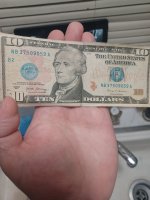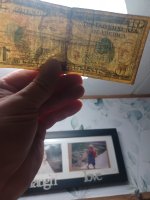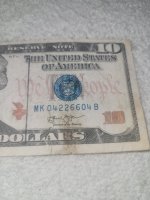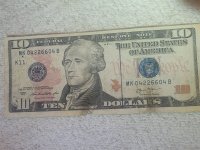Fresh Find
Greenie
- Dec 8, 2023
- 14
- 4
This may be kind of long I hope that's okay.
I have had this 2013 $10 Federal reserve note for a couple years now. done many many hours of research trying to find out if it is legit. Send it into PMG came back with cannot grade altered note. They have graded some in the past but I guess they have reimbursed the folks that had one graded because of this issue being altered.
The Secret service says that it is inkwell contamination. PMG will not give me a reasoning for their conclusion. From all the research that I have done. Without being able to speak with The BEP. And not actually having I guess what I call evidence or whatever in my hand to research it myself. I still believe that it is a legit error. Here's why.
The example I have is perfect. You can see a difference between a chemically altered one and my example which I have came across other ones like mine not all of them are as complete because some will just have the seals blue color or maybe one side will be blue color being the seal and serial number one example I came across it had a blue seal and it started out green but faded into the blue color serial number. It seemed to have started when they started printing large face bills. I have only seen examples of the five tens and 20s. It seems that none of them are the same. It would seem to me that if somebody was doing this to the bills they would want to do all the serial numbers and and both seals rather than a little here a little there especially if they were trying to perfect their craft. As you can see in my photo the black pigments in the serial number are not discolored and you can also see the black dot pigments in a normal Federal reserve note serial number. It is not as a parent in all serial numbers as my example or some others I've ran across. If they mix some kind of inks together the primary three colors are yellow magenta and cyan. Cyan being the same Exact color blue as what's on my $10 note. But I have heard that they use chemicals to create the color of the seals and serial numbers but that too can have alterations.
V can somebody lead me into the right direction of more information maybe like a contact in the BEP. Or somebody that would have first hand knowledge on their process. Any information would be great thanks






I have had this 2013 $10 Federal reserve note for a couple years now. done many many hours of research trying to find out if it is legit. Send it into PMG came back with cannot grade altered note. They have graded some in the past but I guess they have reimbursed the folks that had one graded because of this issue being altered.
The Secret service says that it is inkwell contamination. PMG will not give me a reasoning for their conclusion. From all the research that I have done. Without being able to speak with The BEP. And not actually having I guess what I call evidence or whatever in my hand to research it myself. I still believe that it is a legit error. Here's why.
The example I have is perfect. You can see a difference between a chemically altered one and my example which I have came across other ones like mine not all of them are as complete because some will just have the seals blue color or maybe one side will be blue color being the seal and serial number one example I came across it had a blue seal and it started out green but faded into the blue color serial number. It seemed to have started when they started printing large face bills. I have only seen examples of the five tens and 20s. It seems that none of them are the same. It would seem to me that if somebody was doing this to the bills they would want to do all the serial numbers and and both seals rather than a little here a little there especially if they were trying to perfect their craft. As you can see in my photo the black pigments in the serial number are not discolored and you can also see the black dot pigments in a normal Federal reserve note serial number. It is not as a parent in all serial numbers as my example or some others I've ran across. If they mix some kind of inks together the primary three colors are yellow magenta and cyan. Cyan being the same Exact color blue as what's on my $10 note. But I have heard that they use chemicals to create the color of the seals and serial numbers but that too can have alterations.
V can somebody lead me into the right direction of more information maybe like a contact in the BEP. Or somebody that would have first hand knowledge on their process. Any information would be great thanks











